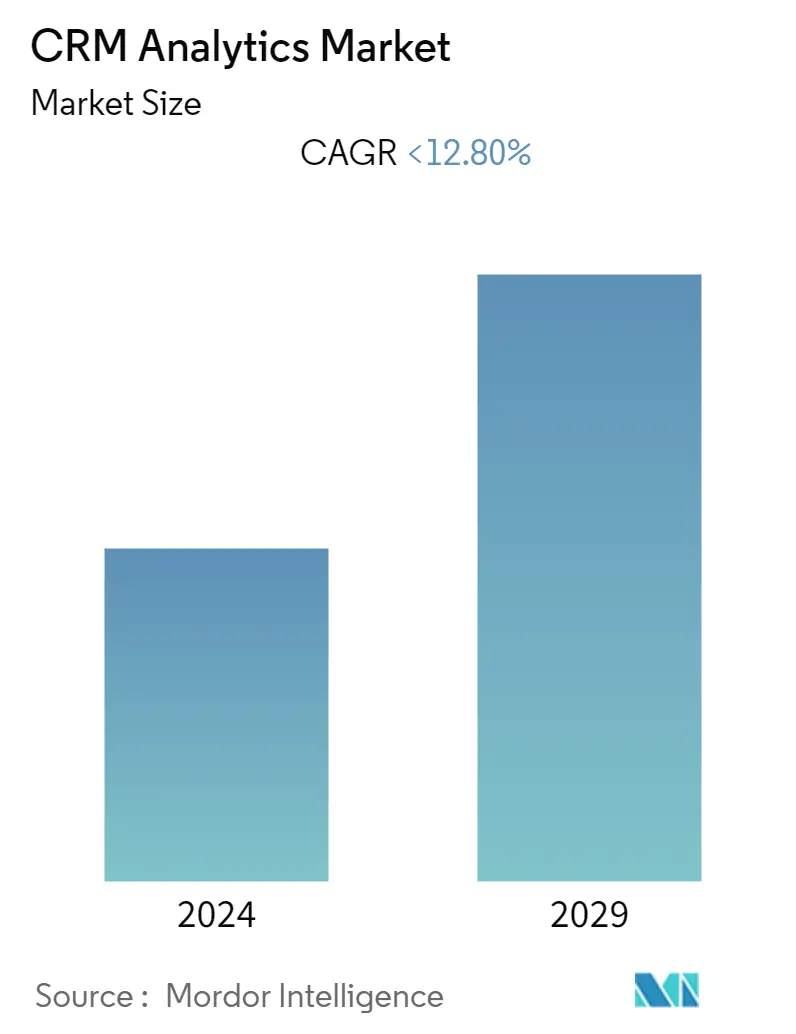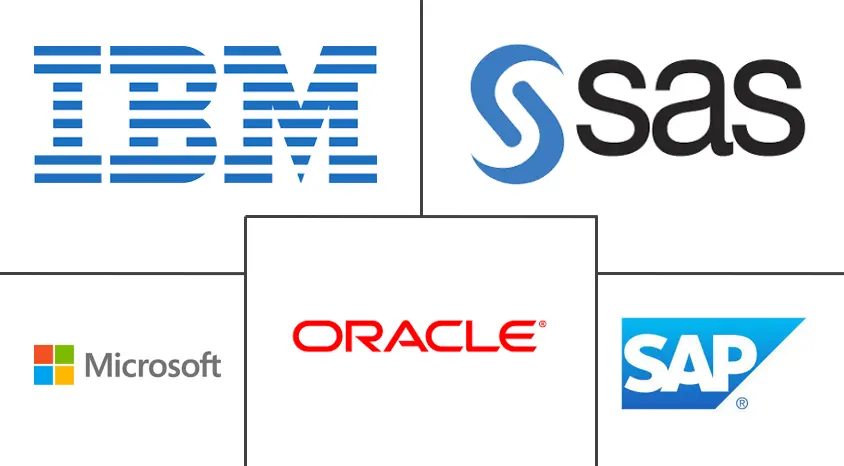Market Size of CRM Analytics Industry

| Study Period | 2019 - 2029 |
| Base Year For Estimation | 2023 |
| Forecast Data Period | 2024 - 2029 |
| CAGR | 12.80 % |
| Fastest Growing Market | Asia-Pacific |
| Largest Market | North America |
| Market Concentration | Medium |
Major Players
*Disclaimer: Major Players sorted in no particular order |
CRM Analytics Market Analysis
The CRM analytics market is expected to register a CAGR of 12.8% during the forecast period. Increased competition among market players, the need to retain important customers, and the rise of big data are the primary factors accelerating the demand for CRM analytics.
- CRM analytics refers to the process of uncovering valuable insights about customers that businesses can act upon from the data that resides in the CRM database. Integration with analytics makes CRM systems more intelligent at comprehending customers and empowers consumers to make data-driven decisions.
- A company's sales team has traditionally managed lead management using customer relationship management (CRM) and data from all human interactions (calls, direct mail, and other marketing tools).CRM has become a necessity for enterprises of all sizes, similar to the role played by the ERP system in managing supply chain activities.
- Further advancements have been announced in the CRM analytics market, such as leveraging speech analytics tools for analyzing the vast amounts of unstructured information pouring into a contact center, which has the potential to evaluate everything from call compliance to sentiment analysis in real time.
- In July last year, Oracle Corporation announced the next generation of Oracle Fusion Middleware. This sales automation application identifies high-quality sales opportunities and guides sellers to close deals faster. Part of Oracle Fusion Cloud Customer Experience (CX) and powered by artificial intelligence (AI), Fusion Sales automatically supplies sellers with quotes, proposals, and recommended steps to assist them in increasing productivity, closing more deals, and instilling confidence among buyers. The introduction of such comprehensive solutions is likely to provide lucrative opportunities for the study market's growth.
- Moreover, the COVID-19 pandemic disproportionately impacted small and microbusinesses, and companies launched CRM applications targeting such companies. For instance, in June 2021, Zoho announced that it began its pipeline-centric CRM for small businesses, which has gained more than 7,500 customers in a year since its launch. Begin is also releasing the latest features, including a mobile pipeline view, to help small businesses enhance customer relationships while recovering from the after-effects of the pandemic.
CRM Analytics Industry Segmentation
Customer relationship management analytics (CRM) refers to applications used to assess a firm's customer data to facilitate and streamline business choices. CRM analytics may also be used for online analytical processing (OLAP) through data mining. CRM analytical tools use a range of applications that help measure customer-related processes' usefulness and eventually provide customer categorization, such as profitability analysis, event monitoring, what-if scenarios, predictive modeling, etc.
The CRM Analytics Market is segmented by Type (Sales and Marketing Analytics, Contact Center Analytics, Customer Analytics), Deployment (On-premise, Cloud), End-user Industry (BFSI, Healthcare, Retail, Telecom and IT, Transportation and Logistics, Media and Entertainment), and Geography (North America (United States, Canada), Europe (Germany, UK, France, Spain, and Rest of Europe), Asia Pacific (China, Japan, India, Australia, and Rest of Asia-Pacific), and Latin America (Brazil, Mexico, Argentina, and Rest of Latin America), and Middle East & Africa (UAE, Saudi Arabia, South Africa, and Rest of MEA). The market sizes and forecasts are provided in terms of value (USD million) for all the above segments.
| By Type | |
| Sales and Marketing Analytics | |
| Contact Center Analytics | |
| Customer Analytics | |
| Other Types |
| By Deployment | |
| On-premise | |
| Cloud |
| By End-User | |
| BFSI | |
| Health Care | |
| Retail | |
| Telecom and IT | |
| Transportation and Logistics | |
| Media and Entertainment | |
| Other End-Users |
| Geography | |||||||
| |||||||
| |||||||
| |||||||
| |||||||
|
CRM Analytics Market Size Summary
The CRM analytics market is poised for significant growth, driven by the increasing need for businesses to harness customer data for strategic decision-making. As companies face heightened competition and the imperative to retain key customers, the integration of analytics into CRM systems has become essential. This integration enhances the intelligence of CRM systems, enabling businesses to gain deeper insights into customer behavior and preferences. The market is witnessing advancements such as the use of speech analytics to process unstructured data in contact centers, which can provide real-time insights into call compliance and customer sentiment. The introduction of AI-powered solutions, like Oracle's Fusion Sales, further underscores the trend towards automation and data-driven decision-making, offering businesses the tools to streamline sales processes and improve customer engagement.
The retail sector, in particular, is experiencing a surge in CRM analytics adoption as companies strive to leverage data for personalized customer experiences. The convergence of CRM and geographic information system (GIS) technologies is enabling retailers to gain insights into consumer behavior and optimize their marketing strategies accordingly. The use of AI tools, such as Algonomy's Xen AI, is helping retailers enhance customer satisfaction by providing tailored experiences based on individual customer profiles. The market is also seeing a rise in e-commerce models, driven by increased smartphone usage, which presents opportunities for vendors to expand their client base. North America remains a key player in the global CRM analytics market, with industries like BFSI, telecommunications, and healthcare contributing to its growth. The competitive landscape is marked by strategic collaborations among major players, such as Oracle, SAP, and Microsoft, aiming to enhance their market share and profitability through innovative solutions and global expansion.
CRM Analytics Market Size - Table of Contents
-
1. MARKET INSIGHTS
-
1.1 Market Overview
-
1.2 Industry Attractiveness - Porter's Five Forces Analysis
-
1.2.1 Bargaining Power of Suppliers
-
1.2.2 Bargaining Power of Consumers
-
1.2.3 Threat of New Entrants
-
1.2.4 Threat of Substitute Products
-
1.2.5 Intensity of Competitive Rivalry
-
-
1.3 Key Merger and Integration Analysis on the Market Vendors
-
1.4 Assessment of Impact of COVID-19 on the Industry
-
-
2. MARKET SEGMENTATION
-
2.1 By Type
-
2.1.1 Sales and Marketing Analytics
-
2.1.2 Contact Center Analytics
-
2.1.3 Customer Analytics
-
2.1.4 Other Types
-
-
2.2 By Deployment
-
2.2.1 On-premise
-
2.2.2 Cloud
-
-
2.3 By End-User
-
2.3.1 BFSI
-
2.3.2 Health Care
-
2.3.3 Retail
-
2.3.4 Telecom and IT
-
2.3.5 Transportation and Logistics
-
2.3.6 Media and Entertainment
-
2.3.7 Other End-Users
-
-
2.4 Geography
-
2.4.1 North America
-
2.4.1.1 United States
-
2.4.1.2 Canada
-
-
2.4.2 Europe
-
2.4.2.1 Germany
-
2.4.2.2 UK
-
2.4.2.3 France
-
2.4.2.4 Spain
-
2.4.2.5 Rest of Europe
-
-
2.4.3 Asia Pacific
-
2.4.3.1 China
-
2.4.3.2 India
-
2.4.3.3 Japan
-
2.4.3.4 Australia
-
2.4.3.5 Rest of Asia Pacific
-
-
2.4.4 Latin America
-
2.4.4.1 Brazil
-
2.4.4.2 Mexico
-
2.4.4.3 Argentina
-
2.4.4.4 Rest of Latin America
-
-
2.4.5 Middle-East and Africa
-
2.4.5.1 UAE
-
2.4.5.2 Saudi Arabia
-
2.4.5.3 South Africa
-
2.4.5.4 Rest of MEA
-
-
-
CRM Analytics Market Size FAQs
What is the current CRM Analytics Market size?
The CRM Analytics Market is projected to register a CAGR of less than 12.80% during the forecast period (2024-2029)
Who are the key players in CRM Analytics Market?
Oracle Corporation, SAP SE, IBM Corporation, Microsoft Corporation and SAS Institute Inc. are the major companies operating in the CRM Analytics Market.

